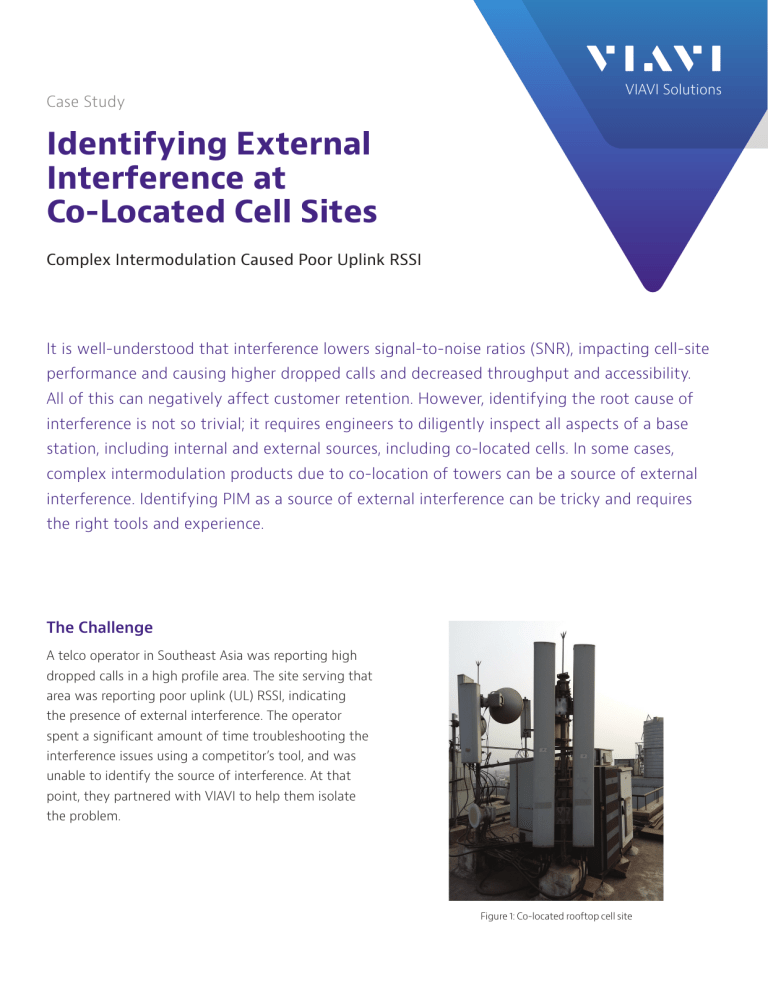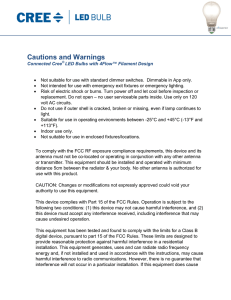Identifying External Interference at Co-Locate Cell Sites
advertisement

Case Study VIAVI Solutions Identifying External Interference at Co-Located Cell Sites Complex Intermodulation Caused Poor Uplink RSSI It is well-understood that interference lowers signal-to-noise ratios (SNR), impacting cell-site performance and causing higher dropped calls and decreased throughput and accessibility. All of this can negatively affect customer retention. However, identifying the root cause of interference is not so trivial; it requires engineers to diligently inspect all aspects of a base station, including internal and external sources, including co-located cells. In some cases, complex intermodulation products due to co-location of towers can be a source of external interference. Identifying PIM as a source of external interference can be tricky and requires the right tools and experience. The Challenge A telco operator in Southeast Asia was reporting high dropped calls in a high profile area. The site serving that area was reporting poor uplink (UL) RSSI, indicating the presence of external interference. The operator spent a significant amount of time troubleshooting the interference issues using a competitor’s tool, and was unable to identify the source of interference. At that point, they partnered with VIAVI to help them isolate the problem. Figure 1: Co-located rooftop cell site Solution The site under investigation was a rooftop site with fiber to the antenna (FTTA) cell-site configuration. Using CellAdvisorTM with RFoCPRI, the team was able to see similar signal peaks on all three sectors, with variable intensity/strength indicating the presence of external interference that was affecting the whole site. However, the Alpha sector reported the highest signal from After performing multiple scans, it appeared that RSSI on UL was maxing near another operator’s antenna. Technically, there should not have been any RF energy coming from that operator’s antenna into the UL the team was investigating. However, a PIM issue at the other operator’s antenna, and the proximity of the two antenna systems, was generating enough RF energy to desensitize he UL spectrum of the VIAVI customer. the interference source. This test confirmed what the operator was seeing at the LTE System Management Radio (LSM-R) interface. The next step was to identify the source of external interference. Figure 3: PIM generating antenna After some time, the other operator replaced the offending antenna, after which our team ran another RSSI scan and did not see the same noise floor increase Figure 2: External interference seen on all three sectors Using the AntennaAdvisor attachment along with the after this change. Using the network based LSMR reports, the VIAVI customer also confirmed that the high RSSI on all three sectors of the cell site was eliminated. CellAdvisor, the team performed a 360-degree RSSI scan of the rooftop, paying close attention to the Alpha sector. Surprisingly, AntennaAdvisor did not show any peaks, but the team did observe a rise in RSSI noise floor when the AntennaAdvisor handle pointed in a certain direction. This observation really piqued the team’s interest, and they decided to perform multiple RSSI scans with the AntennaAdvisor on that rooftop. 2 Identifying External Interference at Co-Located Cell Sites Figure 4: AntennaAdvisor indicating the presence of a strong interference signal in the UL Summary Intermodulation in passive components is created when two or more signals are transmitted in the antenna and cabling system with improper conductivity characteristics. Intermodulation products can not only cause interference issues in the cable and antenna system of a cell site with nonlinear characteristics, it can also become a source of external interference for other cell sectors, especially if the generated PIM signal is in close proximity to other cell sites. Identifying, isolating, and eliminating this interference—quickly—is an absolute must for wireless service providers. CellAdvisor with RFoCPRI capabilities gives providers clear visibility of the uplink spectrum to identify and mitigate interference sources. Contact Us +1 844 GO VIAVI (+1 844 468 4284) To reach the VIAVI office nearest you, visit viavisolutions.com/contact © 2021 VIAVI Solutions Inc. Product specifications and descriptions in this document are subject to change without notice. externalinterference-cs-nsd-ae 30179944 900 1016 viavisolutions.com




